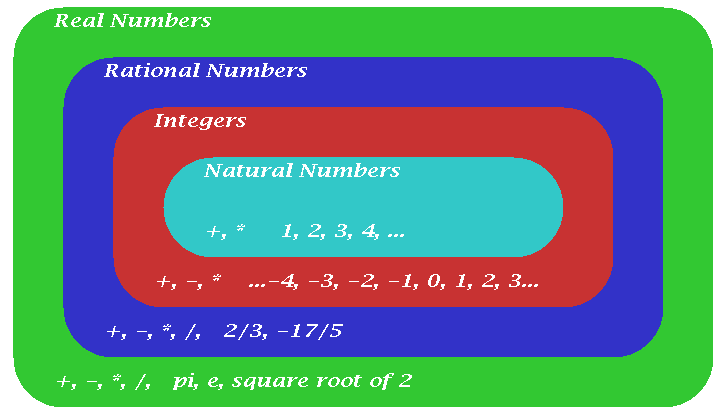

Introduce concepts in a simple context and
then generalize them in such a way that rules and facts that are true
in the simple context remain true in the more general context.
We can add or multiply two natural numbers and obtain
another natural number. However, the difference or the
ratio of two natural numbers is not always a natural number.
For example, 5-2 and 12/3 are natural numbers, but
3-5 and 3/12 are not.
More general sets of numbers can be thought of as being
constructed to make operations always possible that the more
restricted set of natural numbers does not allow. We want to do this
in such a fashion that the usual rules of arithmetic remain true.
These include, for example:
The Natural Numbers.
The natural numbers are
1, 2, 3, 4, 5, ....
These laws are true for all and any natural numbers a, b, c. Actually they hold for all numbers we will encounter, but the whole point of building the number system is that we do this in such a way that the above rules remain true.
The distributive law connects multiplication and addition and is
the most crucial, and the most misused and misunderstood law in the
above list.
The set of integers can be thought of as having been obtained by
expanding the set of natural numbers to make subtraction always
possible. Of course we have to define what we mean by the sum,
difference, product, and ratio of two integers. This is done in the
familiar way with the guiding principle being that the laws listed
above remain valid. (That principle for example leads to the
requirement that the product of two negative numbers is positive.)
The
sum, difference, and product of two integers is always an integer.
The ratio, however, is not, which gives rise to the next level:
The result of adding, subtracting, multiplying, or dividing
rational numbers (so long as we don't divide by zero) is another
rational number. We say that the set of rational numbers is
closed under addition, subtraction, multiplication, and
division.
Of course, after extending the integers to the rational numbers,
we again need to define what we mean by the sum, difference, product, and
ratio of two rational numbers. This is discussed in detail on the page
on fractions.
It can be shown
that there is no rational number whose square equals 2. Hence the
number system needs to be extended once more. For our purposes a
real number is a decimal expression
whose digits may or may not terminate or repeat. It can also be shown
that a real number is rational if and only if its digit repeat or
terminate. Real numbers that aren't rational are irrational
Each number set contains the number sets it surrounds. For example
the set of rational numbers contains all natural numbers (and all
integers). The Figure also indicates which operations are possible in
each set. For example, we can add, subtract, and multiply integers,
and the result will be an integer. (The result of dividing two
integers is not always an integer, for example 5/2 is not.)
The examples given are in the set shown, but not in a smaller set.
For example, 2/3 is a rational number. It's also a real number, but
it's not an integer, and it's not a natural number.
The Integers
The integers include the natural numbers, the
number zero, and the negatives of the natural numbers. Thus they are
..., -3, -2, -1, 0, 1, 2, 3, ....
The Rational Numbers
The rational numbers are ratios of
integers (where the divisor is non-zero), such as 3/4,
-2/17, etc. Note that the integers are included among the
rational numbers, for example, the integer 3 can be written as
3/1, or even 6/2 .
The Real Numbers
It turns out that the rational numbers are not enough to describe the
world. Consider, for example, a right triangle whose two short sides
are each 1 foot long. By the
Pythagorean Theorem, the long side, the
hypotenuse, has a length whose square equals 2. That length is
referred to as the square root of 2.
Hierarchy of Numbers
One of the harder things to understand and appreciate about numbers is
that they form a hierarchy.
Just like all trout are fish, all fish are vertebrates, and all
vertebrates are animals, all natural numbers are integers, all
integers are rational numbers, and all rational numbers are real
numbers. On the other hand, just like some fish aren't trout, some
real numbers aren't rational, some rational numbers aren't integer,
and some integers aren't natural numbers. For some reason this tends
to be very confusing, but it's just like saying that all women are
people, but some people aren't women. (The same goes for men, of
course, and then there are kids too.) Never mind the people, but you
need to understand this language, and be prepared to give examples of
the various types of numbers.
The hierarchy of the number system is illustrated in this Figure:

Complex Numbers
Later in this course we will learn about a yet more general set of
numbers, the complex numbers.